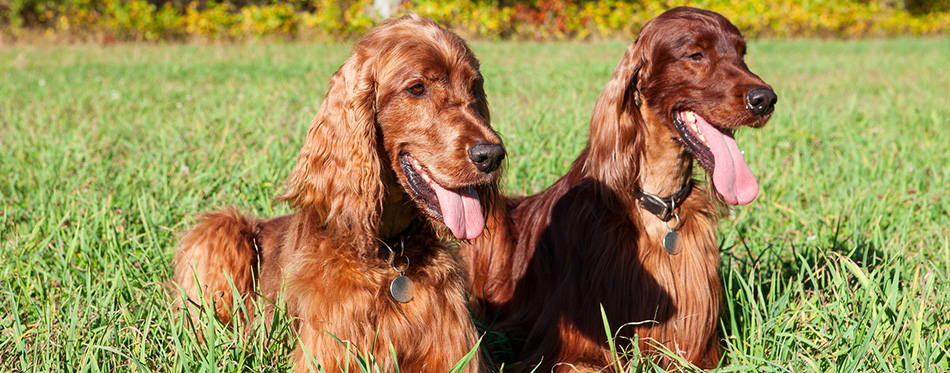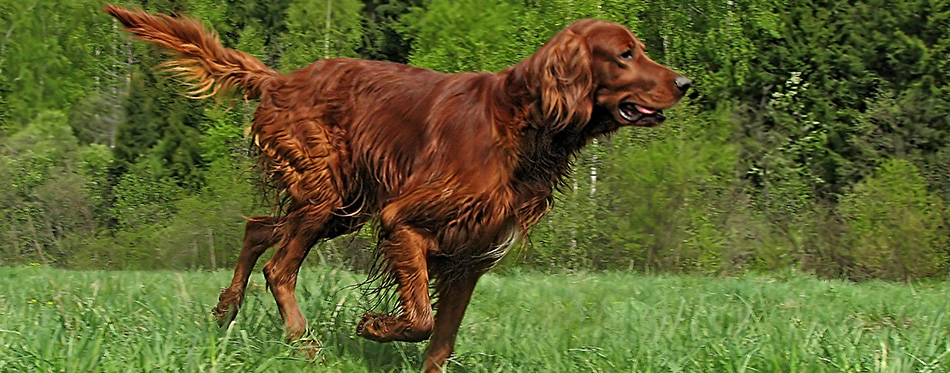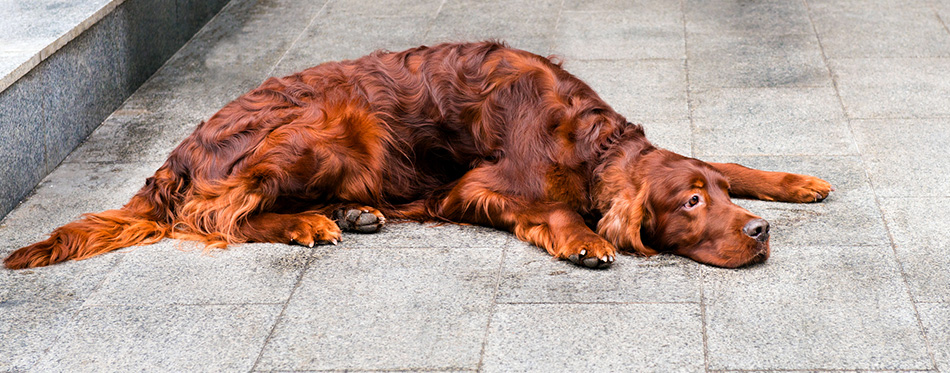Graceful, energetic, whip-smart and fun-loving, the Irish Setter is inarguably one of the most beautiful and beloved dog breeds in the world. This tall and elegantly built canine is most famous for its brilliant mahogany coat which makes it stand out from any crowd. But besides the gorgeous red hair, the Irish is also well-known for its lovable personality – friendly, patient and eager to please, this breed is a joy to have, especially if you have children. The Irish Setter’s partisans would go as far as to say that this is the best dog in the world, and it’s no wonder why – this aristocratic hunting dog is sweet-natured like a Golden Retriever, loyal and intelligent like a German Shepherd and lively and playful like a Labrador Retriever. They really do seem to have the best of all worlds!
However, like all breeds, the Irish Setter has its flaws. For one, they can be really stubborn and mischievous, even too energetic for some people. Of course, they’re also not immune to genetic health diseases. Nevertheless, the Red Setters make for fantastic canine companions.

History of the Red Irish Setter
The Irish Setter was originally developed in Ireland to assist hunters in finding and retrieving game, typically birds. While its exact origins are not clear, the redheaded dog is most likely the descendant of the English Setter, and a combination of Gordon Setters, pointers and spaniels. While the original Irish dogs were white and red, the red Irish Setter is a result of selective breeding – the hunters wanted a dog not only with a keen nose, but one that is easy to spot in cover. According to AKC, the Irish Setter first became popular in the 18th century, while the solid red Irish Setter first appeared in Ireland in the 19th century.
While there is no doubt that the Irish Setter was first developed as a hunting companion dog, what’s interesting about this breed is that they don’t chase the game like most gun dogs do. Instead, they show the hunter the prey they located by “setting” (hence the Setter in their name!) down on their belly or crouching next to it.
Speaking of Setter dogs, one of the first references in literature can be found in De Canibus Britanicus by John Caius, the English physician. In 1576, he wrote that the Setter dog is an invaluable hunting dog, one that makes no noise “either with foote or with tongue, whiles they follow the game.” He also writes that the Setter loyally attends to their master, following their gestures and moves. Once it locates the bird, the Setter freezes, lays down on its belly and doesn’t let go until the master gets to the prey.
Of course, Caius wasn’t talking about the Irish Setter as we know it today. In the 16th century, the Setters, in general, didn’t exist. Instead, Caius was referring to a type of a setting spaniel that is now extinct. So why is this description relevant to today’s Irish Setter? Because for one, the breed is a combination of spaniels and pointers, including the detailed setting spaniel. And two, because the Caius’ breed behavior greatly resembles the one of today’s Irish Setter.
Another reference to the Setter can be found in The Country Farme by Surflet and Markham. In 1616, they wrote that there is a land spaniel which is called the Setter. By the early 18th century, the Setter had made its mark and the Irish had started actively breeding their own type. A century or so later, the Setters in Ireland were predominantly red or mahogany chestnut, either because people preferred dogs of that color (can you blame them?) or because the hunters wanted a dog that was easy to spot in cover. Then, 1862 came and Mr. Cecil Moore, an amateur breeder, set a standard on the appearance of the Irish Setters – his show dog, Champion Palmerston, became a sensation who changed the history of the breed. It is now thought that from this dog most of our modern-day Irish Setters come from.
Today, the Irish Setter is one of the most popular family dogs. With their lovable, loyal and plucky personalities, these dogs make excellent companions. They’re incredibly fun to be around (a huge plus for children), are highly energetic (perfect for active folks), as well as loyal and courageous (ideal hunting companions).
Quick Facts About the Irish Setter
If you’re thinking about getting an Irish Setter, here are quick and interesting facts about the breed that can help you decide if this is the right dog for you and your family.
- The Irish Setter comes in two varieties: a working dog and a show dog. The former is a leaner, shorter breed that is used for hunting and sports, while the latter is larger, more elegant in appearance.
- Regardless of its type, the Red Irish Setter is a swift-moving hunter when on the field. Energetic and fast, the breed is one of the best companions for sports and hunting.
- The (show) Setter can grow anywhere from 23 inches to 28 inches, where the ideal for a male is considered 27 inches at the withers and a weight of about 70 pounds, and for a female 25 inches and 60 pounds.
- The life expectancy of Irish Setters is between 12 to 15 years, which is quite a lot for a purebred, large dog.
- The Red Setter is best known for its deep-rich mahogany or chestnut coat that is fine, glossy and medium in length. Some Setters have small, white specks on their toes, chest or throat, while others have fine streaks of white fur on their heads.
- Despite their glorious coat, the Irish don’t require complex grooming sessions: brushing them twice a week with a proper brush is all it takes to keep them neat and shiny.
- Although they have a reputation for being hard to train, the Irish are actually very easy to teach and train if you know how to work with the breed instead of against it (hint: positive training!).
- The Irish Setter is a highly active breed that required lots of physical activity to stay healthy and mentally sharp.
- They’re also quite mischievous which makes for a fun family pet, but also a difficult-to-deal-with dog if they’re not trained and disciplined as puppies.
- They mature slowly, often taking a few years to grow out of their super-inquisitive, mischievous phase.

Things You Should Know About Red Setter
Whether you already own an Irish Setter or are thinking of getting one, it’s important to know how to best care for them. Here are the main things to know about this breed, including their health, training and exercise, diet, grooming and temperament.
Health
The Irish Setter is generally a healthy dog. But as with all breeds, this one too is prone to certain health problems. Interestingly, for the Irish Setter, a lot of the health issues are to do with its size rather than genetics, although there are a few genetic problems to watch out for as well. The Red Setter is prone to bloat, which is a sudden and life-threatening condition that can thankfully be avoided by feeding multiple smaller meals and avoiding exercise after eating. Besides this, the breed is also prone to hip dysplasia and eye disorders, specifically progressive retinal atrophy, which causes eventual blindness. The Setter is also prone to hypothyroidism, or low levels of thyroid hormone, canine leukocyte and epilepsy. This is also one of the breeds that can develop an intolerance to gluten.
To sum up, here are the health problems and their symptoms to watch out for:
- Bloat: sudden swelling of the abdomen. Signs include a bloated stomach, unsuccessful vomiting, restlessness and panic. Avoid it by feeding multiple smaller meals, and not exercising after eating.
- Hip dysplasia: a genetic condition that affects hips and joints. Symptoms include changed gait, limping, reluctance to climb stairs, lameness in the affected leg.
- Eye disorders: specifically PRA, which is a degenerative disease that eventually leads to blindness. Starts with decreased vision at night, dilated pupils, cloudy eye surface, cataracts… To avoid it, look for responsible breeders.
- Hypothyroidism: lack of the thyroid hormone. Look for symptoms such as low energy, poor growth, mental dullness. Thankfully, the condition is successfully treated with medication.
- Canine Leukocyte: genetic abnormality that affects the immune system. Signs include multiple infections in puppies, specifically gum and umbilical infections. Look for responsible breeders.
- Epilepsy: typically an inherited disorder that causes seizures, although it can be triggered by metabolic disorders. Early prognosis and treatment almost always lead to proper and easy management.
- Gluten intolerance: naturally occurring genetic disorder that affects some Setters. To avoid it, it’s best to avoid giving foods that contain gluten.
Training
The Irish Setter dog is smart, energetic and eager to please breed that is very easy to train if you start on time and you use the right training methods. Indeed, it’s crucial to start training the Irish Setter puppies while they’re small and curious as that’s when they’re most receptive to developing good habits. Early socialization is also recommended as some adult Reds can become unfriendly towards strangers and other animals if not exposed to people and other dogs early on.
You may also like our article on Dog Training Books.
Although very intelligent, the Red Setters have a reputation for being difficult to train. This is due to two reasons, one of which is entirely up to you. One, although affectionate and friendly, this is an independent breed that tends to get bored with things quickly if they find them repetitive. Two, a lot of folks start late with training classes, expecting adolescent Setters to behave properly.
The best way to train the Irish Setter is to:
- Start on time: it’s crucial to start with training and socialization classes early on. You can do this yourself or pay an expert to do it for you. It’s perfectly fine to train the Red Setter yourself though, even if this is your first dog. Just start on time, be consistent and you should have no problems.
- Use positive and fun training methods: because the Setter tends to get bored quickly, it’s important to make their training sessions positive or reward-based and as fun as possible. Setters don’t respond well to harsh corrections so never yell or scream at your dog – instead, encourage the desired behavior and reward them whenever they listen. Tasty treats are a fantastic way to make a training reward-based, plus are tasty and fun for your pup.
Because they’re so athletic and agile, all Irish Setters excel in canine sports, including dock diving, flyball, tracking, hunting, etc. Even if you don’t want your dog to compete, it’s a good idea to expose them to as many sports activities as possible as they love being active and having a purpose.
For more options, check out our detailed review of Dog Agility Tunnels.
Exercise
The Red Setter is one of the most energetic dog breeds. As such, they require plenty of daily exercise. Thankfully, these dogs are also very adaptive and thrive on novelty so you don’t have to jog every single day with them on the leash if you don’t want to – besides jogging, casual walking is also great, and so is hiking and swimming. Ideally, you’ll provide at least 60 minutes of exercise on the daily, but if that’s too much at once for you, you can split it into two 30-minute sessions. This is usually more manageable for busy folks as they can afford to take a 30 minute walk in the morning and a 30 minute hike/run in the evening.
That all being said, even if you and your dog exercise for an hour every single day, it may still no be enough for them. Some Red Setters are extremely energetic and need multiple ways to burn their energy. For such dogs, having a backyard where they can run freely is ideal. Of course, not everyone has a backyard – if you live in an apartment, it’s a good idea to take your pet to a dog park or some other wide-open area every couple of days where they can run freely but safely.
Besides physical exercise, mental exercise is also important for Irish Setters. Because they’re highly intelligent and inquisitive, they should be mentally stimulated every single day. Some daily roughhousing, tugging games, maybe even gentle wrestling is fun and physically demanding – perfect for the Setters. Training classes and various canine sports are another fantastic way to keep your pet both physically and mentally stimulated. Dog toys are also a must-have for this breed.
Nutrition
The Red Setter should be fed a wholesome, high-quality dog food that is appropriate for their age. Irish Setter puppies should be fed food specifically formulated for puppies, adults food made for adult dogs, and older Setters food made for seniors. Their diet should be high in protein and relatively rich in fat as they’re very energetic, and they should also have some complex carbohydrate sources in their diet. That being said, it’s best to avoid gluten-containing foods as some Setters can develop gluten intolerances. So, go for dog foods that are high in quality animal protein and moderately rich in healthy fats (especially omega-3 fatty acids for their beautiful coats) and avoid those made with gluten-containing grains.
Related Post: High Protein Dog Food
Because they’re deep-chested, the Irish Setter dogs are prone to bloat. As such, they should be fed multiple small meals throughout the day rather than two large meals. They should also avoid vigorous exercise around meal times.
Grooming
Although they’re the proud owners of gloriously shiny mahogany coats, the Irish Setters don’t require overly complex grooming routines. They do need to be regularly brushed though – twice to thrice a week with a soft bristle brush or a pin brush, ideally. If your pup is an outdoor pet who is prone to tangles and mats, a long-toothed dog comb can be of great help too.
The Red Setters should also be bathed, but only occasionally – once in two months or so, depending on their lifestyle. When bathing your pet, always brush them first, then bathe with a gentle dog shampoo.
Of course, you’ll also have to trim their nails and brush their teeth regularly. Once a month is recommended for nail clipping, and once a day for teeth brushing (with a dog toothpaste).
Check other dog grooming guides, such as dog nail grinders, dog nail clippers, dog paw washer and dog wipes.

Temperament
The Red Irish Setter is an intelligent, energetic, friendly dog with a rollicking personality. They love and need to be physically active, so they’re best suited for likewise active folks who can provide plenty of daily exercise. They’re also fun-loving dogs who enjoy the company of others – lots of roughhousing, playing fetch and tugging games, as well as cuddling is a must for this enthusiastic and outgoing breed. In fact, the Setter hates being alone – so much that they’re prone to separation anxiety. They’re at their best behavior when around their human family, so may not be a good fit for super-busy folks who travel a lot.
The Irish Setter is a lovable, rambunctious dog, especially around other pets and kids, which makes it a great family pet. However, besides fun, they’re also always up for mischief, so you do need to keep an eye on them. That said, this is the ultimate family dog – beautiful, cheerful, friendly and full of life and energy, they get along with pretty much everyone, especially children.
Source:
- This is the Irish Setter – ISCA
- Irish Setter – AKC

